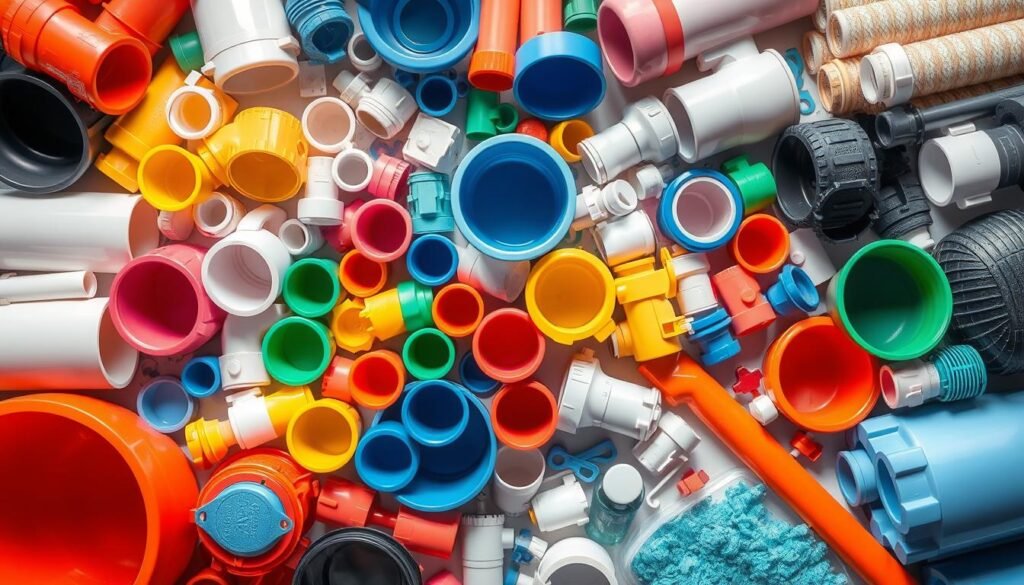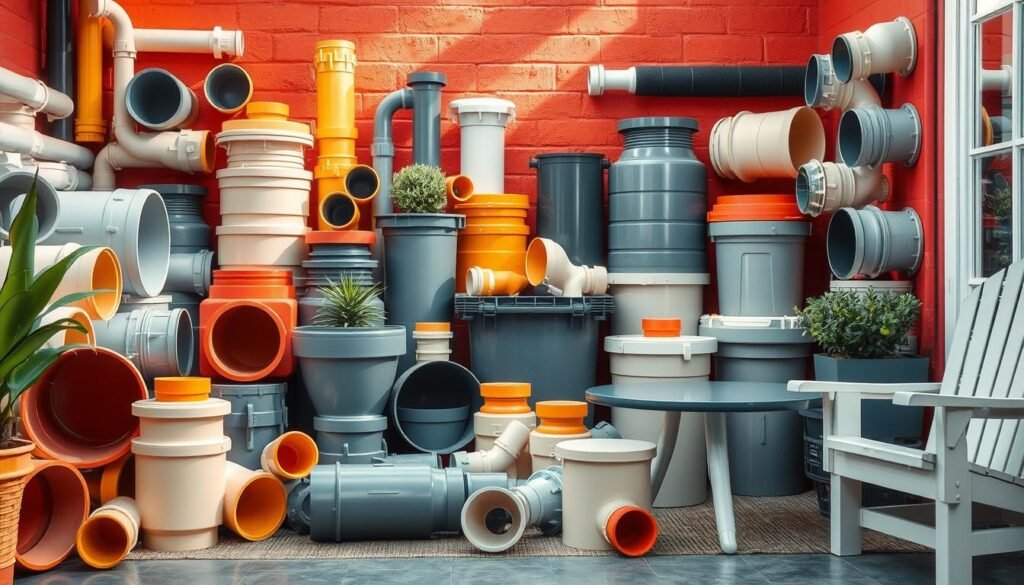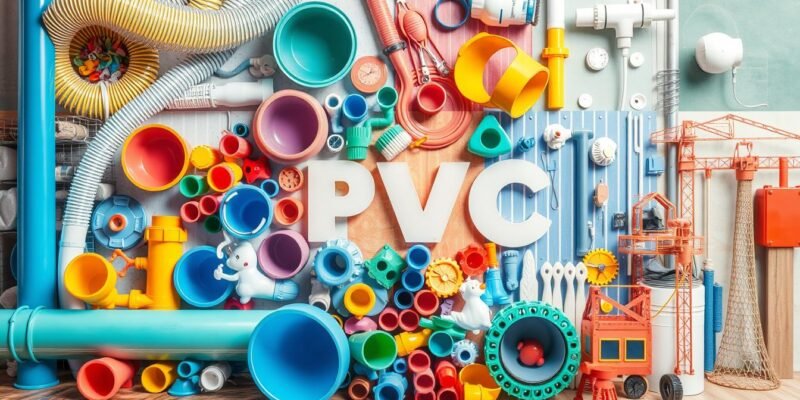Within the landscape of synthetic materials, polyvinyl chloride, or PVC, stands out for its ubiquitous presence across an array of industries and its remarkable versatility of PVC plastic. Synonymous with both practicality and innovation, PVC secures its position as the world’s third-largest type of plastic produced, with around 40 million tons crafted annually to meet global demands1. Its prowess lies not only in its PVC durability but also in an exceptional strength-to-weight ratio, which earns it a respected status in essential applications from plumbing to the critical confines of healthcare facilities where it contributes to life-saving equipment23.
Sustainable PVC solutions emerge from its longevity and formidable resistance to moisture, abrasion, and a wide spectrum of chemicals, ensuring a service life that can exceed 30 years in environments as diverse as construction sites and electrical systems31. The material’s flame retardancy and resilience under adverse climatic conditions further underline the PVC durability, while its economic production and high recyclability reflect our commitment to environmental responsibility and affordability2. Such characteristics not only underscore the polyvinyl chloride applications but also reinforce its role in fostering a sustainable future.
Introduction to PVC Plastic
PVC, or polyvinyl chloride, is a prominent thermoplastic polymer widely recognized for its robustness and longevity. Originating in 1872, PVC has escalated to become the third most manufactured synthetic plastic polymer globally4. Noteworthy for its cost-effectiveness and versatility in applications ranging from construction to healthcare, PVC is synthesized through the polymerization of vinyl chloride monomers, which merge chlorine from sea salt and ethylene from natural resources like natural gas or oil.
The production of this durable PVC material primarily involves processes such as suspension polymerization, emulsion polymerization, and bulk polymerization4. These methods contribute to its distinct properties, including a notable density of 1.38 g/cm3 and the ability to last up to 40 years due to its excellent durability4. By leveraging PVC production methodologies, industries can harness a material with a high tensile strength of 2.6 N/mm2 and a lower likelihood of sustaining fires due to its Limited Oxygen Index (LOI) of above 27%4.

PVC’s application is remarkably diverse, found in rigid forms such as plumbing pipes and window frames and in flexible formats like cables and flooring. Its versatile plastic uses are evident, for instance, rigid PVC, or unplasticized PVC (uPVC), is extensively employed due to its rigidness and resistance to chemicals and weathering4. Conversely, flexible PVC, integrated with plasticizers, caters to needs requiring elastic properties such as tubing and cables4.
The unique characteristics of PVC make it a valuable resource in multiple industries. It is not only pivotal in construction for its robustness and durability but also in the healthcare sector, where products can be sterilized and reused4. Additionally, owing to its acid, salt, base, fat, and alcohol resistance, PVC is optimal for plumbing, including sewage piping5.
| Property | Value | Impact |
|---|---|---|
| Density | 1.38 g/cm3 | Contributes to its durability and stability |
| Tensile Strength | 2.6 N/mm2 | Enables use in high-demand applications |
| LOI | > 27% | Enhances fire resistance |
| Lifespan | Up to 40 years | Ensures long-term utility and cost-effectiveness |
In summary, the characteristics of durable PVC material not only underline its importance in modern-day applications but also emphasize the ongoing need to innovate PVC production for environmental sustainability and efficiency. These attributes make PVC a forefront contender in the evolution of materials within the industrial sector45.
The Essential Properties of PVC Plastic
Within the evolving landscape of material science, PVC (Polyvinyl Chloride) showcases an intriguing blend of durability, resistance, and sustainability. Let’s dissect the attributes that favor PVC as an imperative material across diverse industries.
Resilience to Weathering and Chemicals
PVC chemical resistance ensures it does not react unfavorably to a broad spectrum of chemicals, including oils, acids, and salts6. This attribute, along with its inherent weatherproof PVC material properties, allows it to withstand harsh environmental conditions without degrading, making it ideal for applications in outdoor construction and plumbing78.
Strength and Durability
PVC’s tensile strength is crucial in defining its structural integrity in various applications. For instance, oriented PVC (PVC-O) exhibits tensile strength up to twice that of standard PVC-U, reaching numbers as torquing as 90 MPa in its hoop direction, with an elastic modulus of 4000 MPa7. Moreover, its enhanced impact resistance further solidifies its status as one of the most durable PVC products in the market today7.
Cost-Effectiveness and Sustainability
Sustainable PVC practices are pivotal in the long-term economic and environmental viability of this synthetic material. Approximately three-quarters of all PVC manufactured is utilized in building and construction, providing affordable yet high-quality material options like certified safe PVC pipes for drinking water and energy-efficient vinyl windows8. The base materials for PVC production, rooted in common salt and hydrocarbon feedstock, showcase an efficiency in resource utilization, with 57% of PVC derived from the abundantly available global salt reserves6.
| Property | Tensile Strength | Elastic Modulus | Impact Resistance |
|---|---|---|---|
| PVC-U Standard | 52 MPa | Varies | Moderate |
| PVC-O | 90 MPa | 4000 MPa | High |
| PVC-M | Lower than PVC-U | Varies | Moderate |

Varieties of PVC Plastic and Their Distinctive Features
As we delve into the various types of PVC plastic, we observe a significant division between rigid PVC and flexible PVC. Each category offers unique properties tailored to specific applications, showcasing the versatility of PVC as a material.
Rigid vs Flexible: The UPVC and PVC-P Divide
Rigid PVC, also known as unplasticized PVC or UPVC, is noted for its robustness and absence of plasticizers, which enhances its strength and durability. This makes UPVC applications ideal for construction purposes where material stability is critical, such as in window frames and plumbing systems. Remarkably, PVC is able to resist heat up to 60°C or 140°F9 and can maintain pressure integrity before bursting9.
On the other hand, flexible PVC, known as PVC-P, integrates plasticizers to afford it flexibility and softness, essential for applications requiring malleability such as electrical wire insulation and flooring. PVC-P’s flexibility allows it to handle pressure from hot water and makes it suitable for diverse uses from household to industrial applications9.
Specialty PVCs: From High-Impact to High-Temperature Applications
Specialty PVC types, including high-impact PVC, are engineered to meet the needs of more demanding environments. High-impact PVC, as suggested by the name, offers superior resistance to impact, which is a key consideration in products that must withstand rigorous use. It is resistant to fractures when dropped9 and is chosen frequently for settings that demand durability and reliability.
Furthermore, the ability of PVC to resist acid, alkali, and almost all inorganic chemicals makes it highly valued in industrial settings where such conditions are common10. Ongoing advancements in PVC technology allow its longevity and resilience to push boundaries, with pipes expected to last over 100 years due to high durability standards recognized by numerous international studies10.
In the sphere of specialty PVCs, versatility does not end with robustness. For instance, advancements in PVC-P flexibility involve enhancements in how plasticizers are integrated, thereby extending the range of operation without compromising the material’s intrinsic properties. These modifications offer better performance in extreme conditions, further broadening the scope of PVC applications.
Our dedication to innovation and quality ensures that our customers always receive materials like UPVC and specialty PVC types that not only meet but exceed industry standards. We take pride in providing high-impact PVC and flexible PVC solutions that adapt to both current and emerging market demands. Ensuring high-quality, durable, and versatile products is at the core of what we do.
In conclusion, the diversity of PVC types from rigid to flexible, along with high-impact modifications, allows us to cater to a vast array of industries. This adaptability makes PVC an invaluable material in numerous applications, ensuring efficacy and longevity across uses.
PVC Plastic: Manufacturing and Machining Techniques
As we delve into the complexities of PVC manufacturing processes, it is essential to acknowledge that PVC plastic stands as the third largest plastic produced globally after polyethylene and polypropylene11. The technicalities of fabricating this material involve a blend of innovation and precision, with CNC machining paving the way as the go-to method due to its capability to achieve tight tolerances and refine details with a high level of accuracy12. When machining PVC parts, especially for electrical insulation components, it is paramount to understand that its insulating properties surpass most other CNC plastics, making it a superior choice in the industry11.
In the realm of CNC machining PVC, considerations such as machining speed, friction, and tool longevity are critical11. Experts have found that using corrosion-resistant tools, such as those made of stainless steel, not only maximizes the lifespan of the equipment but also ensures the integrity of the PVC pieces being machined13. Moreover, techniques such as injection molding for PVC and PVC 3D printing, further push the boundaries of what can be achieved in terms of component design and customizability, thereby emphasizing the flexibility and versatility of PVC as a primary material in industrial and technical applications13.
We pride ourselves on adopting environmentally responsible practices by acknowledging PVC to be one of the greenest plastics available—using fewer nonrenewable raw materials in its production and showcasing a smaller carbon footprint relative to other plastics1112. Our mission perpetually steers us toward optimizing our PVC manufacturing processes, where we embrace the challenges encountered, such as the material’s rigidity and thermal sensitivity, and deliberately adapt our methods to surmount them. Through these practices, we ensure the delivery of high-quality and precise PVC parts, sustaining industry trust and fostering our commitment to environmental stewardship13.
FAQ
What are the main uses and benefits of PVC plastic?
PVC, or polyvinyl chloride, is commonly used in a variety of industries, including construction, healthcare, and packaging, thanks to its versatility and range of benefits. Its advantages include durability, resistance to moisture, abrasion, and chemicals, as well as being a sustainable option due to its longevity and cost-effectiveness.
How is PVC plastic produced?
PVC is produced by polymerizing vinyl chloride monomers. This process starts with heating ethylene dichloride without oxygen to form vinyl chloride, which is then polymerized to create PVC. This relies on the key elements of chlorine, which is derived from sea salt, and ethylene, sourced from natural gas or oil.
What makes PVC plastic resistant to weathering and chemicals?
PVC’s molecular structure grants it significant resilience against harsh climatic conditions and prevents it from degrading. Furthermore, PVC’s chemical resistance stems from its lack of reactivity with many substances, including oils, acids, and salts, thereby preserving its integrity in various applications.
What are the differences between rigid and flexible PVC?
Rigid PVC, also known as UPVC or unplasticized PVC, is sturdy and durable without any added plasticizers, making it suitable for construction materials like window frames. Flexible PVC, or PVC-P, includes plasticizers to make it softer and more malleable, which is ideal for applications such as electric wire insulation and flooring.
What are the machining techniques used for PVC plastic?
PVC parts are often created using CNC machining, which is known for its precision in milling and turning processes. It’s important to use corrosion-resistant tools when working with PVC due to its abrasive nature to ensure longer lifespan for the equipment.
Why is PVC considered a cost-effective material?
PVC is deemed cost-effective due to its low resource requirements for production, combined with its longevity and minimal maintenance needs. This affordability does not compromise the material’s quality, making it a preferred choice for a multitude of applications.
Can PVC be used for high-impact or high-temperature applications?
Specialty PVC types have been developed to meet the requirements of high-impact or high-temperature applications. These specialized PVC plastics are tailored to endure extreme conditions without losing functionality.
What sustainability practices can be associated with PVC?
Sustainable PVC practices include recycling and repurposing the material, as well as advancements in the production processes that minimize environmental impact. These efforts contribute to making PVC a more environmentally responsible choice.
How is PVC advantageous for the healthcare industry?
PVC serves a critical role in the healthcare industry by being an essential part of life-saving equipment such as IV bags and blood-collection bags. Its durability, chemical stability, and safety in handling biological materials make it invaluable in medical settings.
Does the type of PVC affect its tensile strength?
Yes, the formulation of PVC can influence its tensile strength. Rigid PVC tends to have higher tensile strength due to its unplasticized composition, while flexible PVC can vary in strength depending on the amount and type of plasticizers used.
